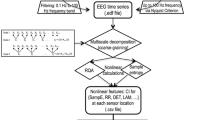Abstract
The understanding of brain activity, and in particular events such as epileptic seizures, lies on the characterisation of the dynamics of the neural networks. The theory of non-linear dynamics provides signal analysis techniques which may give new information on the behaviour of such networks. Methods: We calculated correlation dimension maps for 19-channel EEG data from 3 patients with a total of 7 absence seizures. The signals were analysed before, during and after the seizures. Phase randomised surrogate data was used to test chaos. Results: In the seizures of two patients we could distinguish two dynamical regions on the cerebral cortex, one that seemed to exhibit chaos whereas the other seemed to exhibit noise. The pattern shown is essentially the same for seizures triggered by hyperventilation, but differ for seizures triggered by light flashes. The chaotic dynamics that one seems to observe is determined by a small number of variables and has low complexity. On the other hand, in the seizures of another patient no chaotic region was found. Before and during the seizures no chaos was found either, in all cases. Conclusions: The application of non-linear signal analysis revealed the existence of differences in the spatial dynamics associated to absence seizures. This may contribute to the understanding of those seizures and be of assistance in clinical diagnosis.
Similar content being viewed by others
References
Babloyantz, A. and Destexhe, A. Low-dimensional chaos in an instance of epilepsy. Proc. Natl. Acad. Sci. USA, 1986, 83: 3513–3517.
Bassingthwaighte, J.B., Liebovitch, L.S. and West, B.J. Fractal Physiology, Oxford University Press, 1994.
Elbert, T., Ray, W.J., Kowalik, Z., Skinner, J.E., Graf, K.E. and Birbaumer, N. Chaos and physiology: deterministic chaos in excitable cell assemblies. Physiological Reviews, 1994, 74(1): 1–47.
Frank, G.W., Lookman, T., Nerenberg, M.A., Essex, C., Lemieux, J. and Blume, W. Chaotic time series analyses of epileptic seizures. Physica D, 1990, 46: 427–438.
Fraser, A.M. and Swinney, H.L. Independent coordinates for strange attractors from mutual information. Phys. Rev. A, 1986, 33(2): 1134–1140.
Grassberger, P. and Procaccia, I. Measuring the strangeness of strange attractors Physica 9D, 1983: 189–208.
Grassberger, P. and Procaccia, I. Characterization of strange attractors. Phys. Rev. Lett., 1983 50(5): 346–349.
Lehnertz, K. and Elger, C.E. Spatio-temporal dynamics of the primary epileptogenic area in temporal lobe epilepsy characterized by neuronal complexity loss. Electroenceph. Clin. Neurophysiol., 1995, 95: 108–117.
Liebert, W. and Schuster, H.G. Proper choice of the time delay for analysis of chaotic time series. Phys. Lett. A, 1989, 142(2–3): 107–111.
Lopes da Silva, F.H. and Niedermeyer, E. Electroencephalography: basic principles, clinical applications, and related fields, William & Wikins, Baltimore, 1993.
Osborne, A.R. and Provenzale, A. Finite correlation dimension for stochastic systems with power-law spectra. Physica D, 1989, 35: 357–381.
Pijn, J.P., van Neerven, J., Noest, A. and Lopes da Silva, F.H. Chaos or noise in EEG signals; dependence on state and brain site. Electroencephalogr. Clin. Neurophysiol., 1991, 79: 371–381.
Pijn, J.P., Velis, D.N., van der Heyden, M.J., DeGoede, J., van Veelen, C.W. and Lopes da Silva, F.H. Nonlinear dynamics of epileptic seizures on basis of intracranial EEG ecordings. Brain Topography, 1997, 9(4): 249–270.
Pritchards, W.S. and Duke, D.W. Measuring chaos in the brain — a tutorial review of EEG dimension estimation. Brain and Cognition, 1995, 27: 353–397.
Schuster, H.G. Deterministic Chaos. Physik-Verlag, Weinheim, 1984.
Takens, F. Detecting strange attractors in turbulance. In: D.A. Rand and L.S. Young (Ed.), Dynamical Systems and Turbulence, Lecture Notes in Math. 898. Springer-Verlag, Berlin, 1981.
Theiler, J. Spurious dimension from correlation algorithms applied to limited time-series data. Phys. Rev. A, 1986, 34(3): 2427–2432.
Theiler, J. Estimating fractal dimension. Journal of the Optical Society of America A, 1990, 7(6): 1055–1073.
Author information
Authors and Affiliations
Rights and permissions
About this article
Cite this article
Silva, C., Pimentel, I.R., Andrade, A. et al. Correlation Dimension Maps of EEG from Epileptic Absences. Brain Topogr 11, 201–209 (1999). https://doi.org/10.1023/A:1022281712161
Issue Date:
DOI: https://doi.org/10.1023/A:1022281712161




